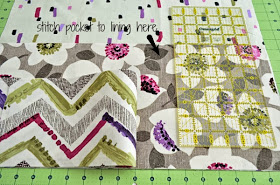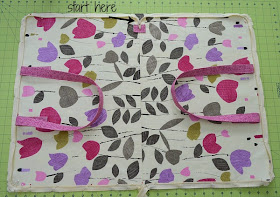It's Day 3 of our Holiday Headstart Blog Hop, where some of our blogging designer friends are sharing tutorials for gifts you can sew for the holidays (or keep for yourself!). Today our Benartex design team shares a classic pincushion. What sets this pincushion apart? Quite simply, it's in the fabric you choose. A fussy-cut stripe, like the one we chose from Maria Kalinowski's Cool School collection for Kanvas, takes this design from ordinary to special. We'll show you how it's done!
You'll Need:
- 1/2 yard Cool School small stripe
- 2-1/2" x 25" black solid strip
- 2 coordinating buttons
- Turning tool
- Clear plastic template material (optional)
- Piece of paper
- Fiberfill
Make the Pincushion:
Start with a small stripe--the smaller the stripe, the more detail you'll see on the pincushion. The frequency of the repeat determines how much yardage you'll need--we used 1/2 yard to allow plenty of cutting options.
To make the triangle template, cut a 6" square from paper. Cut the square diagonally in half twice. You'll use one triangle as a template; discard the rest.
Depending on your preference, you can either trace the paper triangle onto clear plastic template material and cut it out, or simply lay the paper triangle on the fabric and position a ruler over it for cutting.
(You'll see both options shown below.)
Either way, cut 4 identical triangles, being sure the base and the tip of the triangle template hit the stripe in the same place on each triangle.
Choose a different spot on the stripe and cut another 4 identical triangles for the back of the pincushion.
Just for fun, showing you the layout of each side of the pincushion.
Sew 2 matching triangles together along one short side. Check to be sure the stripes are lining up as you sew. Sew 2 more matching triangles together.
Press seams in opposite directions so they'll nest when you join them.
Sew the 2 halves together, and then join the 4 triangles to make the opposite side of the pincushion.
Trim each square to measure 5". Make sure to line up the seams with the diagonal line on the ruler and check that the 2-1/2" intersecting mark on the ruler lines up with the center of the pieced square.
Pin the 2-1/2" x 25" black strip to one side of the square. Start sewing the strip to the square, leaving at least 1" unsewn at the starting point. Continue sewing the strip to the square, stopping 1/4" from each corner and pivoting before continuing down the next side.
If you find this pivoting technique to be tricky, here's a tip. Stop 1/4" from the edge of the square with the needle in.
Lift the presser foot and rotate the square and strip. Take one stitch.
Lift the presser foot and rotate the strip so the raw edges align with the next side. That one stitch will help you pivot the strip more smoothly.
After sewing around the fourth corner, stop and remove pincushion from your machine. Press the beginning strip back 1/4", creating a seam allowance. Lay the end of the strip down and press so the folded edges match. Trim excess strip 1/4" past this fold.
Pin the strip ends together with folds matching and stitch together down the fold line. Add the second pieced square in the same manner, leaving an opening for turning. Tip: Press the created "corners" into the black strip to ensure that the second square will line up with the first square. Turn right side out, poke corners with a turning tool, and stuff with fiberfill. Slipstitch the opening closed.
The finishing touch: Add a button to the center of each side. Tip: Knot a doubled length of thread and pass back and forth a few times to squish the centers in, and then add the button each side. Easier than trying to aim through those button holes right away!
Finished pincushion side 1:
Side 2:
If you're looking for a different way to use stripes on this pincushion design, check out our "Ho-Ho-Ho, Let It Snow" version. We used the stripe on the side and alternated two prints for the triangles. For a smaller pincushion, start with a smaller square for the template.
Don't miss the other tutorials featured in our Holiday Headstart blog hop:
Day 1: Take Me to Class Tote by Tessa from The Sewing Chick
Day 2: Window Zip Pouch by Emily from Mommy's Nap Time
Day 4: Bold Braid Quilt by Kelly from My Quilt Infatuation



































































